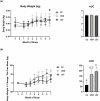Aromatase Inhibition Eliminates Sexual Receptivity Without Enhancing Weight Gain in Ovariectomized Marmoset Monkeys
- PMID: 35592515
- PMCID: PMC9113444
- DOI: 10.1210/jendso/bvac063
Aromatase Inhibition Eliminates Sexual Receptivity Without Enhancing Weight Gain in Ovariectomized Marmoset Monkeys
Abstract
Context: Ovarian estradiol supports female sexual behavior and metabolic function. While ovariectomy (OVX) in rodents abolishes sexual behavior and enables obesity, OVX in nonhuman primates decreases, but does not abolish, sexual behavior, and inconsistently alters weight gain.
Objective: We hypothesize that extra-ovarian estradiol provides key support for both functions, and to test this idea, we employed aromatase inhibition to eliminate extra-ovarian estradiol biosynthesis and diet-induced obesity to enhance weight gain.
Methods: Thirteen adult female marmosets were OVX and received (1) estradiol-containing capsules and daily oral treatments of vehicle (E2; n = 5); empty capsules and daily oral treatments of either (2) vehicle (VEH, 1 mL/kg, n = 4), or (3) letrozole (LET, 1 mg/kg, n = 4).
Results: After 7 months, we observed robust sexual receptivity in E2, intermediate frequencies in VEH, and virtually none in LET females (P = .04). By contrast, few rejections of male mounts were observed in E2, intermediate frequencies in VEH, and high frequencies in LET females (P = .04). Receptive head turns were consistently observed in E2, but not in VEH and LET females. LET females, alone, exhibited robust aggressive rejection of males. VEH and LET females demonstrated increased % body weight gain (P = .01). Relative estradiol levels in peripheral serum were E2 >>> VEH > LET, while those in hypothalamus ranked E2 = VEH > LET, confirming inhibition of local hypothalamic estradiol synthesis by letrozole.
Conclusion: Our findings provide the first evidence for extra-ovarian estradiol contributing to female sexual behavior in a nonhuman primate, and prompt speculation that extra-ovarian estradiol, and in particular neuroestrogens, may similarly regulate sexual motivation in other primates, including humans.
Keywords: androgen excess; bone density; diet-induced obesity; estrogen depletion; neuroestrogen; nonhuman primate model.
© The Author(s) 2022. Published by Oxford University Press on behalf of the Endocrine Society.
Figures





References
-
- Killinger DW, Perel E, Daniilescu D, Kharlip L, Blackstein ME. Aromatase activity in the breast and other peripheral tissues and its therapeutic regulation. Steroids. 1987;50(4-6):523-36. - PubMed
-
- Kadioglu P, Oral G, Sayitoglu M, et al. . Aromatase cytochrome P450 enzyme expression in human pituitary. Pituitary. 2008;11(1):29-35. - PubMed
-
- Weisz J. In vitro assays of aromatase and their role in studies of estrogen formation in target tissues. Cancer Res. 1982;42(8 Suppl):3295s-3298s. - PubMed
Grants and funding
LinkOut - more resources
Full Text Sources
